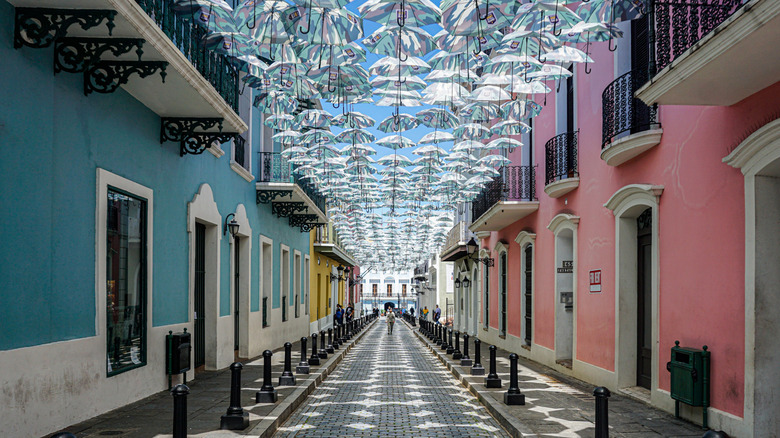This Caribbean 'Island Of Enchantment' Is Becoming More Popular Among Tourists
"Want to travel to a Caribbean island?" Ask almost anyone from the United States this question, and the answer will probably be a resounding, "Yes!" If there's any hesitation, you might add, "There are beaches. Colorful old towns. And rainforests full of waterfalls." At that point, most people will be chomping at the bit. "Where are we going?" Then the reveal: "Puerto Rico!"
Mainland Americans tend to overlook Puerto Rico, instead booking flights to Barbados, Aruba, or Turks and Caicos, but this is changing. Puerto Rico is a U.S. territory with more than 120 direct domestic flights per day. The island has enjoyed a 5% growth in tourism in 2025, a positive sign for a land historically devastated by hurricanes, earthquakes, and federal neglect. If you're a U.S. citizen with a valid Real ID, you don't need a passport to enter; just step off the plane and into a tropical paradise, as if you were visiting any other state.
Yet Puerto Rico isn't like any other state. Nicknamed "La Isla del Encanto" (Island of Enchantment), this land of 3.2 million people has quaint towns, lively festivals, vast outdoor spaces, more than 300 miles of coastline, and 200 individual beaches. Around half of Puerto Ricans speak some English, and an estimated 20% are fully bilingual, so monolingual American tourists shouldn't have trouble getting by. The U.S. dollar is the official currency, and the local time zone is Atlantic Standard Time, one hour ahead of New York and Miami. Keep these facts in mind, plus other essential travel hacks when visiting Puerto Rico, like packing attire for the beach and the city, and you'll kick off a vacation that's smooth, hospitable, and full of adventure.
The many enchantments of Puerto Rico
Puerto Rico is often summed up in a single image — of San Felipe del Morro, a 16th-century fort in San Juan. The fort looks out over the sea, and its battlements boast distinctive round towers, built from stone. Known locally as "El Morro" (The Promontory), this stronghold is the most iconic sight in Puerto Rico, drawing more than 2 million visitors each year. The structure is a picturesque, historic marvel: Spanish settlers started its construction in 1533, but it wasn't considered "finished" until 1790. After El Morro, photographers tend to focus on the pastel-colored facades of Old San Juan, which flaunt the distinctive architecture of colonial Latin America.
As magical as these destinations are, there's far more to Puerto Rico than old buildings. San Juan is a vibrant, modern city with about 320,000 residents and rich ethnic diversity. The urban dining scene showcases local specialties, like plantain-based mofongo and tamale-like pasteles, but you'll also find other types of Latin cuisine, Pan-Asian restaurants, and burger joints. The nightlife scene in San Juan is renowned across the Caribbean, and many tourists fly here to party and make new friends. Note that the piña colada was invented in Puerto Rico and is considered the island's national drink.
Apart from the capital city, you have an entire island to explore – about 100 miles in length. The territory is extremely motorized, with well-paved highways and winding byways. A growing number of road trippers are taking advantage of La Ruta Panorámica, a 167-mile scenic route through Puerto Rico's stunning landscapes.
Getting around Puerto Rico and where to visit
Most travelers will explore Puerto Rico by rental car; mass transit is great in San Juan, but it is much patchier in the countryside. Taxis and private shuttles are common here, but you can cross the whole island in about two hours by car, making driving the most convenient option. Driving also makes it easier to reach less-known nooks and explore the dreamy Puerto Rican waterfalls for pristine swimming. The island has a bustling resort culture and overflows with organized tour options, including trademark experiences, such as kayaking through bioluminescent bays and tropical hiking. The coast is dotted with dive shops, and the waters have similar clarity and biodiversity as more popular Caribbean beaches.
One of the most striking getaways in Puerto Rico is also luring in travelers. The satellite island of Vieques is secluded, beautiful, and has a long-revered LGBTQ+ community. You can fly here from San Juan or take the ferry from the eastern town of Ceiba. In Vieques, wild horses roam on beaches, and the water glows with breathtaking bioluminescence. When you visit Puerto Rico, you will see for yourself what everyone has (finally) started talking about.


